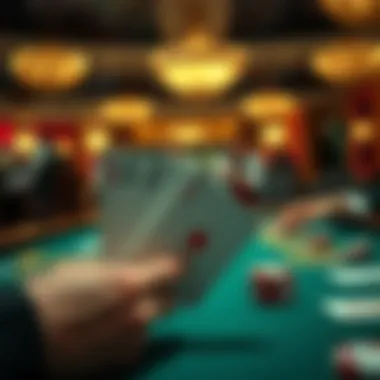Mastering Blackjack: Strategic Insights on Splitting


Intro
In the world of blackjack, the choices you make can be the difference between hitting the jackpot or walking away empty-handed. One of these pivotal decisions involves whether to split pairs, a move that can rattle the cage of even seasoned players. Understanding when this strategy can be beneficial requires not just a grasp of the basic rules but also a nuanced insight into the dynamics of the game.
Blackjack isn't merely about luck; strategic maneuvering plays a significant role. The act of splitting pairs needs careful consideration of your hand, the dealer's upcard, and various other factors determining the outcome of the game. Making an informed choice can maximize your chances of winning and reduce your potential losses.
The upcoming sections will provide an in-depth look at how and when to split, the strategies that underpin these choices, and the implications of your decisions at the table. Prepare to delve into the nuances that separate the casual player from the professional, and equip yourself with knowledge that elevates your game to a new level.
Understanding the Basics of Blackjack
To master the game of blackjack, it’s crucial to have a solid grasp of its foundational principles. Knowing how the game operates isn’t just about the rules; it’s about comprehending why those rules exist and how they directly affect your strategy. Familiarity with the basics provides the groundwork for more advanced concepts like when to split your cards, making it a pivotal section of this discussion.
The goal of blackjack is to beat the dealer without going over 21. Players compete against the house, not each other. You try to get a hand value as close to 21 as possible, while ensuring it’s higher than the dealer's total. Understanding the dynamics of the game can vastly improve your chances of winning and minimize losses.
The Objective of the Game
At its core, the objective in blackjack is straightforward: accumulate cards that total 21 or come closer to that number than the dealer does, without exceeding it. This simplicity belies the complexity involved in decision-making during the game. Players need to assess their hand’s value, evaluate the dealer's visible card (the upcard), and make tactical choices based on those assessments. For instance, a player might opt for hitting more often when the dealer shows a low card, as it increases the chances of the dealer busting—a circumstance that favors the player.
Basic Rules and Gameplay
Blackjack follows a set sequence of play that beginners should familiarize themselves with:
- Card Values: Number cards count as their face value. Face cards (kings, queens, and jacks) are worth ten, while aces can be worth one or eleven, depending on what benefits the hand.
- Initial Deal: Each player receives two cards, face up, while the dealer gets one card face up and another face down. Don’t let that hidden dealer card fool you; many outcomes hinge on its value.
- Player Decisions: After receiving their cards, players must choose to hit (take another card) or stand (keep their current total). The strategy can shift dramatically depending on whether the player's total is low or high, and especially when considering the dealer's upcard.
- Dealer’s Turn: Once all players finish, the dealer reveals their hidden card. The dealer typically must hit until reaching a total of 17 or higher, which can directly affect player outcomes.
- Winning: If your total exceeds 21, you bust and automatically lose. If the dealer busts, you win. Otherwise, hands are compared at the end to determine higher totals.
These basic rules are the building blocks for understanding when and how splitting can be an advantageous tactic in blackjack. As players navigate the game, they'll realize that their strategic choices often hinge on a firm understanding of these elementary principles.
Jumping into splitting without that base knowledge is like putting the cart before the horse. It’s essential to appreciate how your hands can evolve as the game progresses to maximize your odds effectively.
"Knowing the rules is only part of the journey. Mastery comes when you understand how to apply them strategically."
For players serious about improving their skills, exploring resources like Las Vegas Rules can provide additional insights into how these basic principles interplay with more complex strategies. Whether you're a novice or looking to refine your game, approaching blackjack from a foundation of solid understanding is vital.
What Does Splitting Mean?
When it comes to blackjack, the term splitting refers to a specific action taken by players when they receive a pair of cards of the same value. Rather than playing them as a single hand, players separate the cards into two distinct hands, each having its own stake. This maneuver opens the door to additional opportunities for winning, but it also requires a solid understanding of its mechanics and strategic implications. Navigating the choice to split effectively can mean the difference between walking away victorious or nursing a loss.
The Mechanics of Splitting Cards
Splitting cards is straightforward but comes with its own set of rules that every player should familiarize themselves with. Once a player is dealt two identical cards—like two eights or two tens—they can opt to split them. Here’s how that works:
- Initial Stake Adjustment: Upon deciding to split, the player must match their initial bet for the new hand. For a pair of eights, if the original bet was $10, an additional $10 goes on the new hand.
- Playing the Hands: After splitting, the game continues separately for each hand. Players will take turns playing their hands individually, hitting and standing as they see fit.
- Limitations on Splits: Some casinos place restrictions on how often you can split. For example, you may only split once or may not be able to split Aces more than once. Players should check the table rules to avoid surprises down the road.
- Drawing Cards: After splitting, players can draw to each of their new hands. Generally, if you split Aces, you may only receive one card for each hand, while other splits allow for multiple draws.
This mechanism not only impacts how a round unfolds but can also increase or decrease the total number of potential winning outcomes depending on how well you manage each hand.
Strategic Implications of Splitting
Understanding the implications of splitting goes beyond the immediate mechanics; it’s about leveraging statistical advantages and reading the game effectively. Here are some key strategic considerations:
- Doubling Down Opportunities: Sometimes, after splitting, players can double down on their new hands. This is particularly advantageous when one of the hands is strong, allowing for larger potential wins.
- Facing the Dealer's Upcard: The dealer’s visible card can significantly affect the strategy behind splitting. For instance, if the dealer shows a weak upcard such as a 4 or a 5, making a split could enhance your chances while they potentially bust.
- Understanding Pair Statistics: Not all pairs are created equal. Depending on the value of your pairs, the decision to split can vary. For instance, splitting eights is generally favorable, as it turns a losing hand into two chances to win, whereas splitting tens, usually discouraged, means leaving a strong hand behind for a gamble.
"Being methodical about when to split is just as crucial as knowing when to hold your horses. Every card tells a story, and it’s up to you to read it right."
In summary, splitting serves not only as a mechanism of play but also as a strategic advantage that can be wielded with great effect when applied correctly. Players who take the time to analyze their situations, evaluate their hands, and consider the dealer's upcard will find themselves better prepared to manipulate the odds in their favor. Through thoughtful decision-making, one can transform a simple splitting maneuver into a powerful tool for success at the blackjack table.
When to Consider Splitting
Deciding to split in blackjack isn't just a matter of chance; it relies heavily on strategy and an understanding of your hand versus the dealer's. Each player at the table must analyze their situation carefully to determine if splitting would be advantageous. Misjudging the moment to split can lead to significant losses, while choosing wisely can double your chances of winning. This section focuses on key elements and benefits that players should weigh before making such a critical decision.
Evaluating Your Starting Hand


When it comes to blackjack, the hand you start with sets the stage for the entire game. Players often hold pairs – two cards of the same rank – providing the perfect opportunity to split. But not all pairs are created equal. Here’s a breakdown of how to evaluate your starting hand:
- High-value pairs: Pairs like Aces or Eights often warrant splitting, as they provide higher potential for creating two strong hands.
- Low-value pairs: Conversely, pairs such as Twos, Threes, or Fours can be tricky. They might not hold enough strength individually, making it less beneficial to split them.
In deciding whether to split, consider the total points in your hand against the best possible outcome from splitting. Striking that balance is key.
The Role of the Dealer's Upcard
The dealer's upcard is arguably one of the most significant factors influencing your decision to split. Imagine you have a pair of Aces, and the dealer's upcard is a Five. In this situation, splitting is often a wise move because you have the chance to capitalize on the dealer’s weaker position. However, let's consider other scenarios:
- Strong Dealer Upcards: If the dealer shows a Ten or an Ace, splitting might not be the best strategy. You risk the chance of facing a stronger hand. In such cases, it’s often better to stand or hit instead.
- Weak Dealer Upcards: The opposite is true when the dealer displays a low card (like a Two through Six). Here, splitting can be a strong move. The dealer is forced to draw and may bust, thus giving you a better chance to win.
Analyzing both your hand and the dealer’s upcard creates a clearer picture of your potential to win. Players should adjust their strategies based on these dynamics, fully aware that the outcome can drastically change with just one card.
"In blackjack, the real dance happens between your hand and the dealer's upcard; it’s like a game of chess where every move counts."
Understanding when to split based on your hand and the dealer's visible card is essential for mastering the art of blackjack, turning the tide in your favor.
Common Splitting Scenarios
When it comes to blackjack, understanding the various scenarios that call for splitting your cards can be a game-changer. Each pair has its own unique dynamics, and knowing how to approach each situation greatly affects your probability of a favorable outcome. While splitting can offer substantial rewards, it also comes with an inherent risk. Learning to evaluate these situations sheds light on how to maximize your strategy at the table.
Pair of Aces
Splitting a pair of aces is a classic move among seasoned players. When you receive two aces, you have a golden opportunity. Each ace can stand alone, facilitating a chance at achieving a natural blackjack with a Ten-value card. The power here lies in the flexibility that comes with these high-value cards. But be cautious; not all tables allow you to regain your initial bet on these hands. Some may dictate that each ace counts as a single hand, meaning you only get one additional card per hand. Therefore, it’s imperative to be familiar with the rules of your specific table. Splitting aces can be a high-score tactical maneuver, especially facing a dealer’s weak upcard, such as a Four, Five, or Six.
Pair of Eights
Eights may not appear as glamorous as aces, but splitting them is often a strong choice. This move is generally advised due to the fact that 16, which results from keeping both eights together, is widely considered a bad hand. By splitting, you're not only improving your prospects of hitting a 20 but also minimizing the risk of busting with the lower value of eight. If the dealer shows a low card, it can shift the momentum of the game in your favor. Staying alert to the dealer's upcard while determining whether to split can skew the odds in your favor. Players often rejoice after pulling this split, as it allows them to chase after stronger hands.
Pair of Tens
The thought of splitting tens can stir up quite a debate. Many seasoned players actually recommend against splitting this pair. Holding a total of twenty is strong, likely leading to a winning hand. However, some players may be tempted to draw a couple of new cards, looking for the potential of two winning hands. This approach will often yield more losses than gains, especially when tables are loaded with aggressive players. The odds are not necessarily in favor of that split. Hence, weighing the current table dynamics before making that leap is essential.
Other Pairs: Strategic Insights
Other pairs like twos, threes, or nines each come with their own strategic implications. For instance, twos and threes can collectively work well against a dealer's weak upcard, potentially creating opportunities for small wins. This particular split is often more about making moves that disrupt the dealer's total. On the other hand, nines have unique situations, where splitting may be favorable or detrimental based on the dealer's showing card.
To make a calculated decision, you should consider the context:
- Current Hand Value: Weigh the total value after splitting.
- Dealer’s Upcard: Assess the current situation at the table.
- Player Position: Recognize how your position will interact with the overall luck of the table.
In essence, every pair demands a thoughtful analysis of not just your cards, but also how they interact with the dealer's cards and the dynamics of play in your current game. Engaging with these nuances is what transforms a good blackjack player into a great one.
Analyzing the Odds
Understanding the odds is crucial when playing blackjack, especially when it comes to deciding whether to split your cards. Splitting pairs can significantly shift your chances of winning, but this decision should be rooted in a careful analysis of probabilities and outcomes rather than impulse. When players overlook the math behind splitting, they may find themselves facing unnecessary losses.
To make informed decisions, players must take a closer look at the probabilities associated with various hands. Specifically, knowing the likelihood of improving one's hand after splitting, the potential consequences of the dealer's upcard, and the overall deck composition can wield substantial influence over the game's outcome. Let's break this down further through the sections to follow.
Probability Considerations
When weighing the decision to split, one must consider the probabilities tied to the remaining cards in the deck. Each pair split creates two distinct hands, each with its odds of winning against the dealer.
- Example for Consideration: If you hold a pair of eights, splitting gives you two separate chances to reach 21. The blackjack dealer stands a chance to bust, especially if they are showing a lower card like a 5 or 6, which also impacts your winning probabilities.
- Mathematical Clarity: If you split your eights, each hand will undergo different outcomes based on oncoming cards. Statistically, you have a greater likelihood to produce a strong hand when the deck is rich in tens or face cards.
Overall, these probabilities can alter your handling of a split dramatically. If the deck is favorable, splitting not only enhances your winning odds but can also leverage your position against an aggressive dealer.
Statistical Benefits of Splitting


Apart from the basic probabilities, deep statistical insights provide further clarity on the benefits of splitting pairs.
- Increased Chances: According to numerous blackjack tables of probabilities, when you split pairs like Aces or Eights, the odds lean favorably in your direction, often doubling potential returns. When you do the math, these scenarios often result in a net increase of your winning potential.
- Dealing with High Cards: It becomes evident that by splitting a pair of Aces, you will have the opportunity for two separate strong openings. This strategy effectively doubles your chances against most dealer upcards.
- Cost-Benefit Analysis: However, it's not all roses. When the potential bust rate goes up with certain low-value cards in your hand, especially early in the game, the stakes could backfire. For instance, splitting a pair of Tens against a dealer's Ace might not yield the same benefits as splitting Aces. Thus, your typical analytical move would be to factor in the situational context first.
In summary, a thorough analysis of the odds gives keen insight into splitting strategies. By judiciously evaluating probabilities and tapping into the statistical advantages, players arm themselves with the necessary insight needed to articulate their move effectively.
Risk and Reward of Splitting
In blackjack, the decision to split can either bolster your position at the table or set you back a step. Understanding the risk and reward of splitting is crucial for making informed choices that could impact your bankroll and overall success. The right split at the right time can transform a mediocre hand into a winning endeavor, but with potential rewards also come inherent risks.
Potential Benefits
When you choose to split, there are several advantages that can come into play, making the decision worthwhile.
- Maximized Opportunities
In splitting a pair, you effectively create two separate hands from one. This means twice the chances to form a winning hand. For instance, if you're dealt a pair of Aces, splitting allows you to double down on two potentially powerful starting points rather than risking it all on a single hand. - Enhanced Control
Splitting gives you greater agency over your bets and allows for the possibility of winning two hands instead of just one. With astute card management, the probability of success generally increases as you can adjust your strategy based on the outcomes of each hand. - Strategic Advantage
Moreover, from a psychological perspective, the act of splitting can be a strategic move against the dealer. A player who exhibits confidence in their hand and knows how to leverage splitting can influence the game dynamics, making it more challenging for the dealer to hold their own.
Downsides to Splitting
While splitting has its merits, it's also riddled with drawbacks that should not be ignored.
- Increased Risk Exposure
By choosing to split, you essentially double your investment. If you’re not careful, that can lead to more significant losses compared to playing one hand. For example, if you’re dealt a pair of 10s and you split, you might end up with two weaker hands instead of holding a strong hand of twenty. Sizing your bets appropriately becomes crucial when considering splits. - Limited Options for Further Play
After splitting, you are often faced with limited options on the hands dealt subsequently. Some rules may restrict your ability to double down or take further hits on your split, which could leave you in a precarious position. - Vulnerability to Dealer's Cards
The dealer's upcard can significantly influence the outcome of your split hands. If the dealer shows a strong card, your chances of winning diminish, making your seemingly advantageous split turn sour. Keeping an eye on the dealer's showing could lead to missed opportunities in deciding when to split.
"Success at the blackjack table is often about weighing the risks and rewards. Splitting too often or too rarely can cost you dearly, so tread carefully!"
Each of these aspects needs consideration when you think about splitting in blackjack. Mastering the art of splitting entails a solid understanding of when to capitalize on it and when to hold back. Your approach should almost always reflect both an appreciation of the potential upsides and a cautious respect for the risks involved.
Advanced Splitting Strategies
Understanding the nuances of splitting in blackjack goes beyond basic strategies; it involves sophisticated techniques that can significantly affect your overall game. Advanced splitting strategies enable seasoned players to capitalize on favorable situations while minimizing potential losses. These strategies not only improve your chances of coming out ahead but also add an intriguing layer of complexity to the game. By digging into advanced techniques, players can align their moves with the dynamics of the table and the tendencies of their opponents.
Card Counting and Splitting
Card counting, a technique often associated with blackjack mastery, serves as a cornerstone for many advanced strategies, including splitting. The basic premise of card counting is to keep track of the ratio of high cards to low cards remaining in the deck. When the deck is rich in high cards, the odds favor the player. Understanding when to split pairs using this knowledge can be the difference between a winning and a losing session.
How it Works
When you apply card counting, you'll notice that the decision to split can vary based on the count. For instance, if you have a pair of eights and the count is high, splitting them becomes an attractive option because it increases your chances of drawing a ten-value card, resulting in two strong hands. Conversely, a low count might suggest that the deck is filled with lower cards; thus, being cautious with splitting could be wise.
In card counting, making educated decisions can turn the tide in your favor.
Practical Considerations
- Keep the Count: Always maintain a running count. This will aid in evaluating whether to split or not, based on the current makeup of the deck.
- Communicate with Your Cards: Understanding your cards' potential based on the remaining cards can significantly alter your approach.
- Observe the Dealer: The dealer's upcard can also inform your decision. For example, if the dealer has a low upcard and you’re in a favorable count position, splitting could put you in a powerful position.
Incorporating card counting into your strategy requires practice but can yield significant returns. By blending solid card counting with effective splitting techniques, you gain a robust strategy that stands up against many variables.
Player Position and Its Impact
Player position at the blackjack table is often underestimated, yet it plays an integral role in developing advanced playing strategies, including splitting decisions. Your position relative to the dealer and other players can influence not only your action but also the dealer's potential responses.
Why Position Matters
In blackjack, your position dictates the sequence of play. Those seated later have the advantage of observing how earlier players handle their hands, especially when it comes to splitting. If the table is tight, with players opting for less aggressive plays, you might feel more emboldened to split on strong counts.
Additionally, consider the dealer's upcard. If they show a weak card, you are in a prime position to take aggressive splitting actions. For instance, splitting pairs can allow you to capitalize on the dealer's vulnerability. This scenario puts you ahead, especially if you draw well.
Key Takeaways
- Evaluate Environment: Observe the dynamics of your table; it informs your decisions.
- Stay Aware: Note how others play their hands, as it may influence your approach to splitting.
- Read the Room: Be aware of the dealer's upcard alongside your position; this can turn the game in your favor.


In essence, advanced splitting strategies are a blend of mathematical rigor—like card counting—and situational awareness regarding player positioning. By refining these techniques, players can develop a strategic edge that enhances their overall performance at the blackjack table.
Adjusting Your Strategy
In the game of blackjack, merely knowing when to split your cards doesn’t cut the mustard. A savvy player must also consider various aspects that pertain to the gaming environment. This section delves into the critical nature of adjusting your strategy, especially how it can significantly impact your odds and overall experience at the table.
Understanding Table Rules
Table rules, which might seem like small potatoes, play an essential role in shaping your approach to the game. These rules can vary drastically from one casino or online platform to the next. Imagine sitting down at a table where double down options are severely limited or where splitting aces is frowned upon – these nuances can determine whether your strategy flops or flourishes.
Here are a few key rules to keep in mind while adjusting your strategy:
- Splitting Rules: Some casinos allow resplitting, where you can split again after splitting. Others might not, thus limiting your options significantly if you end up with more pairs.
- Doubling After Splitting: This is crucial when you split aces or eights. Adjusting your strategy based on whether or not you can double after splitting can yield more favorable outcomes.
- Croupier Rules: Know how the dealer must draw cards, particularly in soft totals. If the dealer stands on 17, you might choose to play a bit more aggressively when considering splits.
To encapsulate, understanding the intricacies of table rules provides a solid foundation upon which to build your splitting strategies. In a game as unpredictable as blackjack, being well-informed helps you steer clear of pitfalls.
Adapting to Player Behavior
The art of situational awareness in blackjack cannot be overstated. Observing how other players at your table act can offer significant insights. If everyone around you seems to hit on 16, you may want to reassess your own tendencies. This is where the term game dynamics comes into play.
Here are some player behavior cues to watch out for:
- Aggressive Players: If the player on your left is splitting tens, you might want to adjust your approach. Aggressive gameplay can sometimes lead to a more conservative style in response from others.
- Nervous Bets: Players who hesitate and seem unsure may not fully grasp the rules. Understanding their level of experience can inform your own decisions. For instance, if an inexperienced player consistently busts, you might adopt a more aggressive strategy knowing they’re unlikely to challenge your splits effectively.
- Pattern Recognition: Noticing how many players are sensitive to the dealer’s upcard adds another layer of strategy. A shift in their behavior during favorable dealer cards could be your cue to change how you play your hands.
Ultimately, adapting to player behavior aligns your strategy with the evolving dynamics at the table. It turns the focus from just your hand and the dealer’s upcard onto the broader picture of the game as a whole.
"In blackjack, it's less about the cards you hold and more about the players you’re playing with."
By grasping these into consideration, you increase your probability of making smarter decisions regarding when to split your blackjack hands. In the end, successful gameplay is a dance between knowing the rules, reading the collective mood, and adjusting your strategy accordingly.
Practical Tips for Splitting
When it comes to splitting in blackjack, having practical tips can make all the difference between a successful hand and a costly mistake. In a game where every decision counts, understanding the nuances of splitting becomes crucial. Not only does this enhance your gameplay, but it also enables you to navigate the table dynamics effectively.
Managing Your Bankroll Effectively
One of the vital components of any gambling strategy lies in the management of your bankroll. Setting a budget before you even sit down at the table can help keep your emotions in check. Without a clear limit, you risk chasing losses - a path that often ends poorly.
Here are some key considerations for effective bankroll management during splitting:
- Set Clear Limits: Determine how much you are willing to wager on any given hand and stick to it. If it's only a few bucks, no problem!
- Determine Split Capital: Decide how much of your bankroll you will earmark specifically for splitting. This way, if your initial splits don’t turn out favorably, you still have funds to play with.
- Be Conservative with Splits: Not every pair deserves a split. Assess your situation and bet conservatively. Pairs less favorable, such as a pair of fours, may not warrant splitting at all.
- Use a Win/Loss Ratio: Track your wins and losses, adjusting your split decisions based on performance. If you notice a trend, you might need to recalibrate.
Psychological Considerations
Beyond the arithmetic, the psychological aspect of splitting should not be overlooked. Emotions can run high, and the stakes can blur judgment. Here are some psychological insights that should guide your splitting strategy:
- Control Anxiety: It’s easy to feel pressured when the dealer's upcard seems favorable to them. But remember, panic decisions can lead to regret. Calm your nerves and rely on your strategy.
- Avoid Superstitions: Don't fall into the trap of letting luck dictate your decisions. Rely on clear strategy rather than superstition; the outcome is determined by probabilities, not fate.
- Understand Impulsiveness: Players often jump to split out of habit, rather than strategic thinking. Recognize these tendencies and strive to make deliberate decisions based on the factors at play.
- Practice Mindfulness: Take a moment between hands to assess your emotional state. A clear mind can greatly enhance your decision-making abilities.
Inummary, effective bankroll management combined with a strong grasp of psychological factors creates a winning strategy for splitting in blackjack.
The End: Mastering the Art of Splitting
In the grand tapestry of blackjack, the act of splitting pairs holds significant weight for players aiming to enhance their gaming prowess. This strategy, when executed correctly, can transform a mediocre hand into a powerful one. Understanding when to split and how to approach it can mean the difference between walking away from the table with a smile or with empty pockets.
Mastering the art of splitting isn't just about knowing the basic rules; it’s about grasping the subtle nuances that will allow you to play more effectively against the dealer.
Specific Elements of Splitting Strategy
- Assessment of Your Hand: One of the first steps is evaluating the strength of your pairs. Certain pairs, like aces and eights, warrant an instant split due to their strategic potential. Conversely, splitting tens may not always yield favorable outcomes.
- Dealer’s Card: The dealer's upcard can vastly alter your decision-making process. If the dealer shows a strong card, it might be tempting to play conservatively, but against weaker cards, you may want to take the offensive and split.
- Bankroll Management: Splitting doubles your bets on those hands. Adopting a strategic approach to bankroll management will help ensure you don’t pull the rug out from under yourself with reckless splits.
- Psychological Factors: Players must navigate their own psychology as well. The chatter of fellow players, combined with the pressure of the game, can cloud judgment. Remain calm and make decisions rooted in strategy rather than emotion.
"In blackjack, it's not just about the cards you're dealt. It's about how you choose to play them, especially when it comes to splitting."
Benefits of Mastering Splitting Strategy
The benefits of mastering this strategy are multifaceted. Firstly, players become more adaptable, able to pivot their tactics based on the dealer's upcard and their pairs. This adaptability often results in improved winning rates. Secondly, a well-timed split can significantly increase your gains on a hand that could otherwise be a loser.
On the other side of the coin, it’s crucial to recognize that splitting is not without its pitfalls. Oversplitting in the heat of the moment can lead to ramshackle outcomes. Understanding when to engage with a split and when to resist the urge is an essential part of the gambler’s journey.















